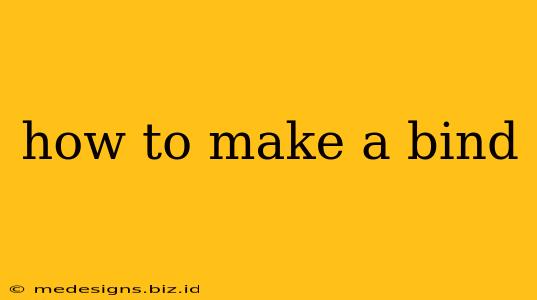Creating a bind, whether for a book, document, or other materials, might seem straightforward, but achieving a secure and aesthetically pleasing result requires the right techniques. This guide explores various methods and considerations for making different types of binds, catering to various skill levels and project needs.
Understanding Different Binding Methods
Before diving into the specifics, let's explore the common types of binding:
1. Saddle Stitch Binding:
This is the simplest method, ideal for booklets with a relatively low page count (typically under 48 pages). Pages are folded in half and secured with staples along the spine. It's cost-effective and quick, perfect for brochures, newsletters, and short reports.
Pros: Cheap, fast, easy. Cons: Limited page capacity, not suitable for thick documents.
2. Perfect Binding:
This method, frequently used for paperback books and magazines, involves gluing the edges of the pages together to create a square spine. The cover is then wrapped around the glued block. It allows for a larger page count than saddle stitch.
Pros: Clean look, accommodates a higher page count. Cons: More complex than saddle stitch, requires specialized equipment for large-scale production.
3. Spiral Binding (Coil Binding):
A plastic or metal coil is inserted through pre-punched holes along the spine. This method is flexible, allowing the book to lie flat. It’s a popular choice for notebooks, calendars, and reports.
Pros: Durable, pages lay flat, allows for easy page turning. Cons: Can be somewhat bulky, holes can weaken the pages.
4. Wire-O Binding:
Similar to spiral binding, but uses double-loop wire instead of a coil. This creates a professional and sophisticated look. It's often used for high-quality presentations, calendars, and notebooks.
Pros: Elegant, durable, pages lay flat. Cons: More expensive than spiral binding, requires specialized equipment.
5. Case Binding:
This is the most robust and durable binding method, often used for hardback books. The sections are sewn together, glued to the cover boards, and then covered with cloth or leather. This method offers superior longevity.
Pros: Extremely durable, professional appearance, suitable for large and heavy books. Cons: Most expensive and complex method, requires specialized skills and equipment.
Choosing the Right Binding Method: Key Factors
The best binding method depends on several factors:
- Page Count: Saddle stitch is limited, while perfect, spiral, wire-o, and case binding handle larger page counts.
- Budget: Saddle stitch is the cheapest, followed by spiral binding, while case binding is the most expensive.
- Aesthetics: Consider the desired look and feel of your final product. Wire-O binding offers a sleek, professional look, while perfect binding is clean and simple.
- Durability: Case binding offers the highest durability, followed by wire-O and spiral binding.
Tools and Materials You'll Need
The specific tools and materials will vary depending on the chosen binding method. However, some common items include:
- Paper: Choose a paper weight appropriate for your project.
- Stapler (for saddle stitch): A heavy-duty stapler is recommended for thicker documents.
- Glue (for perfect binding): Use a strong, acid-free adhesive.
- Punch (for spiral and wire-O binding): Ensure the punch is compatible with your chosen coil or wire.
- Coil or Wire (for spiral and wire-O binding): Choose the appropriate size and material.
- Cover Stock: For added protection and a professional finish.
Step-by-Step Instructions for Common Binding Methods
Detailed, step-by-step instructions for each binding method are beyond the scope of this single article. However, numerous online resources and tutorials offer comprehensive guidance for each technique. Search for "[Binding Method] tutorial" to find specific instructions.
Conclusion: Mastering the Art of Binding
Learning how to make a bind is a valuable skill, whether for personal projects or professional applications. By understanding the different methods and selecting the appropriate technique for your needs, you can create high-quality, durable, and aesthetically pleasing bound documents. Remember to research the specifics of your chosen method for a successful outcome.
